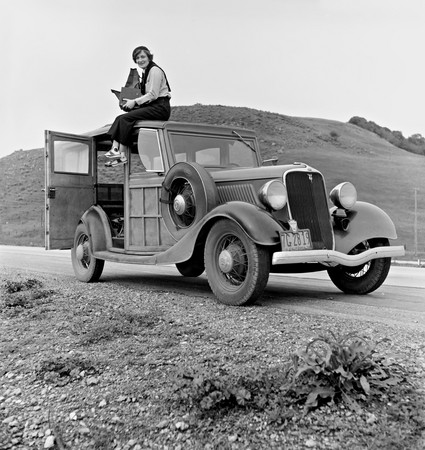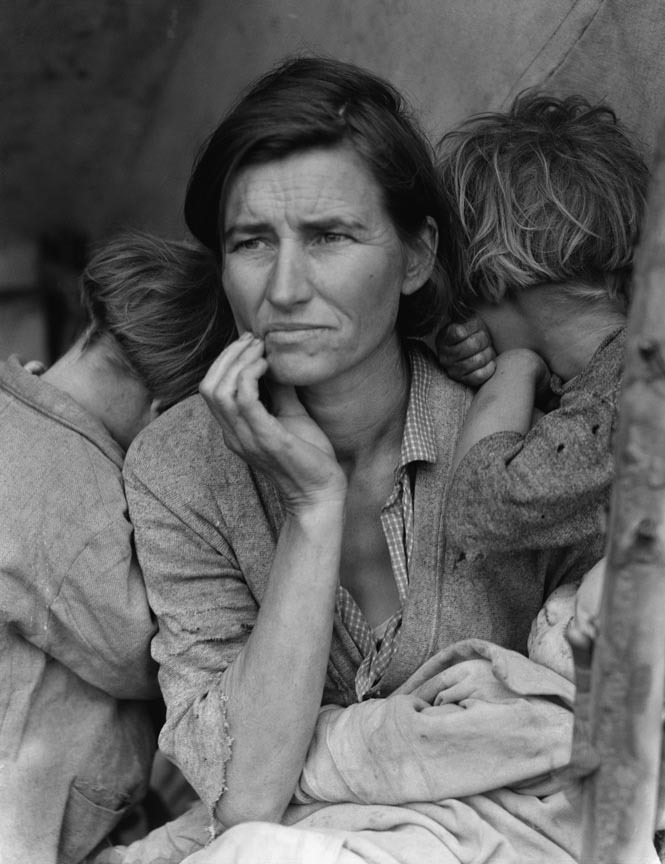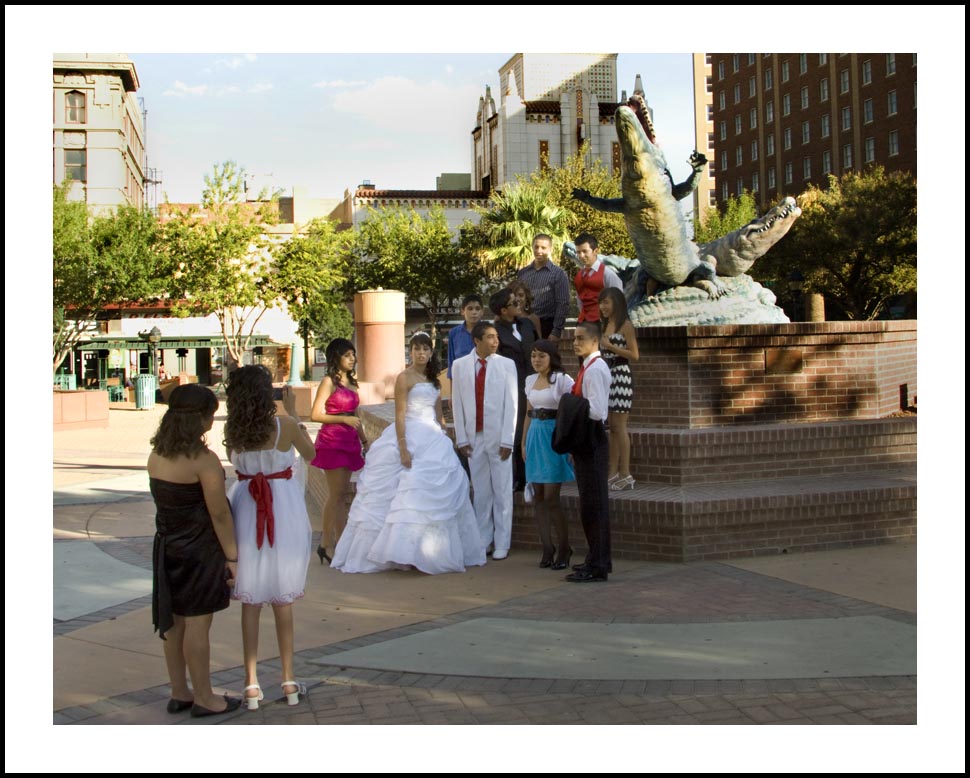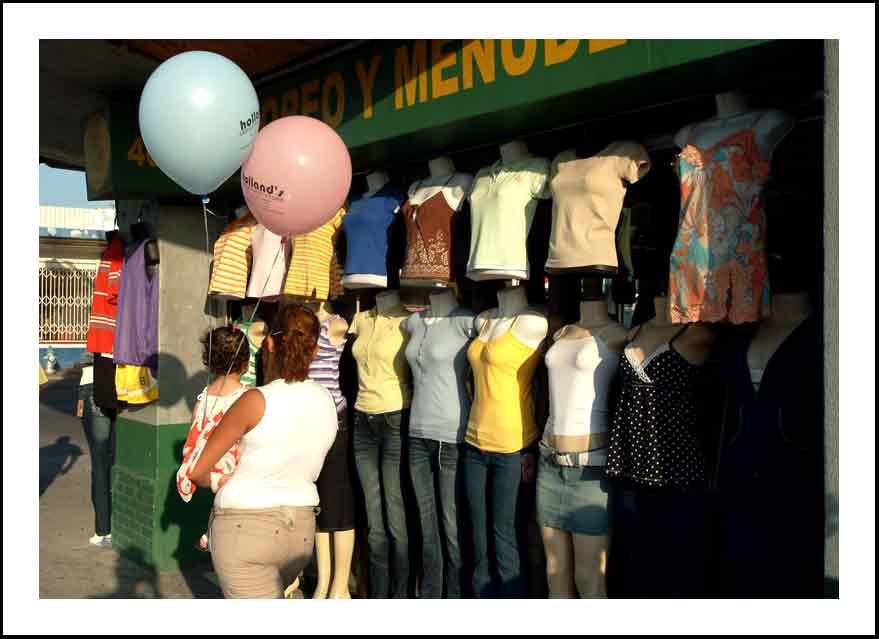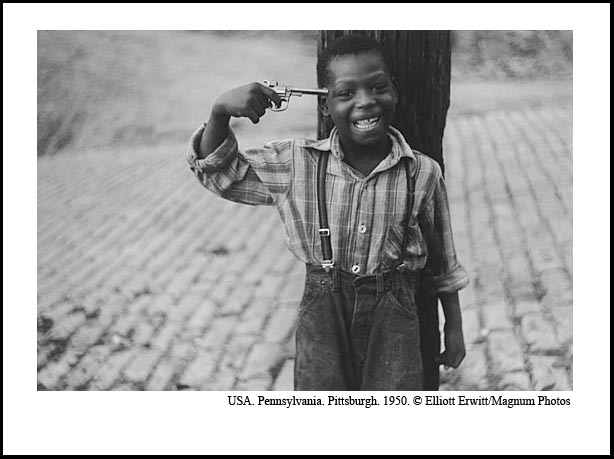Photograph of Dorothea Lange,
Resettlement Administration photographer,
in California, c. 1936
The car is a 1933 Ford Model B (AKA “V8”).
She is -as well as Russell Lee and the other FSA photographers- the spiritual “Godmother,” of this site.
_______________________________
This is a picture of Dorothea Lange, at work. She was one of my earliest influences (the other was Weegee). I decided I wanted to be a photographer because the work she was doing mattered and helped create understanding between communities and put “face,” to people who needed to be seen and known. Everything I have done since, particularly The Border Project, has been dedicated to her and to that idea.
Thank you, Dorothea.
Now, many years later, I am wondering. I’m wondering what it takes to get people to feel and get people to put others in front of their own wants and needs. I thought, if you made pictures like Dorothea’s, people would go right to the content and act from their hearts. I thought these kind of images were the foundation of a “New Day,” where, always, leaders considered those below, Los Abajos, first and that the ones above, Los Ricos, were held at bay by our leaders, because we had this great and profound document from the past, photos, like those of Dorothea Lange.
Is that the way it is now?
I don’t think I know anymore.
I’m wondering if people are able to see content even when it’s put in front of them. It seems like they’re more than able to see style and decorativeness, but, content? No se?
If I showed you pictures of a neighborhood, populated by handsome and proud people, say some place like the Segundo Barrio, their very postures screaming I AM SOMEBODY, I MATTER, I AM RICH, do people see that or do they see how they can use the picture for, for what? Do some people use photographs of this kind to appropriate the people and things in them and turn them from realities into things? For their houses? Placed in their Board Rooms and over their couches?
Do they see the people and their hearts or do they just see a design, color, a mere thing, art, a picture?
Docoration versus content. Take your choice.
I have never made pictures with the intention of decorativeness. That was secondary. Maybe I was too successful at making the pictures “pretty.” Maybe that’s why I don’t sell many pictures. My intention was to find a way to convey content and the content has always been, pretty much, pictures from those abajo, below, like the south side of El Paso, and those pictures have all been about Homage, an appreciation and an admiration.
Today I was thinking about all that because I came across this photo of Dorothea. I’ve always admired her as a teacher, a hero, someone older, wiser, somebody up there above me. I never thought of her as just a cool woman, sitting on top of her ride, wearing the cool sneakers, working the camera.
This picture makes me ask myself, Did she think she succeeded.? How mad was she at the people who were throwing the poor off the land? When she shot Migrant Mother (picture below), did she think it would change the plight of the dispossessed? What were her hopes? Her disappointments. In this picture, shot by her boyfriend and later, husband, Paul Taylor, she was a “kid,” groovin’, probably thinking anything and everything was possible.
I don’t know the answers. I’m struggling with the questions.
I’m wondering if it matters to go on with this pursuit.
Who are Dorotheas’s , or my, or any documentary photographer’s pictures aimed at? How do we make them matter? How can the point be made, with pictures, with video, with words, that one is supposed to respond and act upon information, not just say “uh huh,” and consume it? Must we be restrictive on where we allow them to be presented to try and prevent the misappropriation of them, turning them from socially concious content, to un-thought-about decoration.
Doesn’t sound right, does it?
Dorothea’s pictures were created by her for a government-created organization (the Farm Security Administration, or, FSA) to help aleviate the suffering of the poor.
Today there is a full intensity effort on the part of our government, our media, many many of our politicians, so-called “leaders,” and many of our citizens to even acknowledge that there are any poor.
Everyone can rise, we’re told every election, by people who have risen, and hang out with other people who have risen, to the mythical American Dream. Oh yeah! Give them an Arts Block, give them three dollar coffee, give them electronics and watch everyone blossom into an esthetic and enriched being! Oh yeah…Hooo Baaaaaa!
It’s easier that way.
For them.
It is argued that we now tune out the graphics of reality, like Dorothea’s kind of pictures, because we’re overloaded with imagery. Just too many images out there.
I think some of us tune out what we tune out simply because we choose to and greed is being encouraged and is, for the moment, ascendant. We want everything. You can have it all. Zero per cent. It’s easy to believe fairy tales. I thought these kind of pictures were fairy tale busters. Maybe they were. Now, I really am not sure.
Maybe that’s why, reportedly, most of Dorothea’s last days were spent tending to her garden in Oakland.
You do what you can, I guess.
One thing is for sure. Dorothea Lange’s pictures do matter and have lasted and been remembered long after the robber barons, the predatory bankers, the heartless pimp/lawmakers, and the inept businessmen of her day have faded away into the shameful shadows of the past.
They were important then and they’re important now. To ignore their content is to be on the wrong side of history.
Artifacts -and content– do matter.

